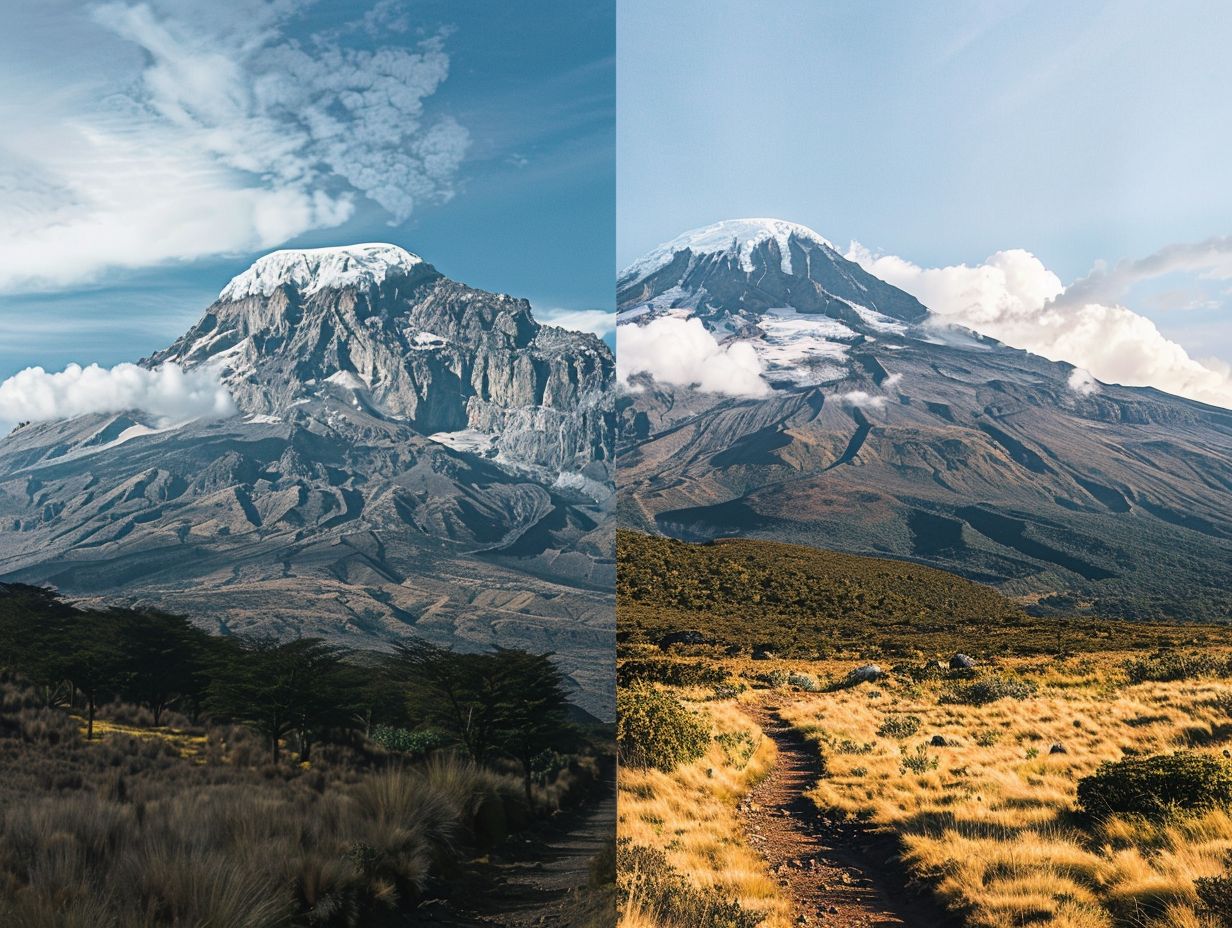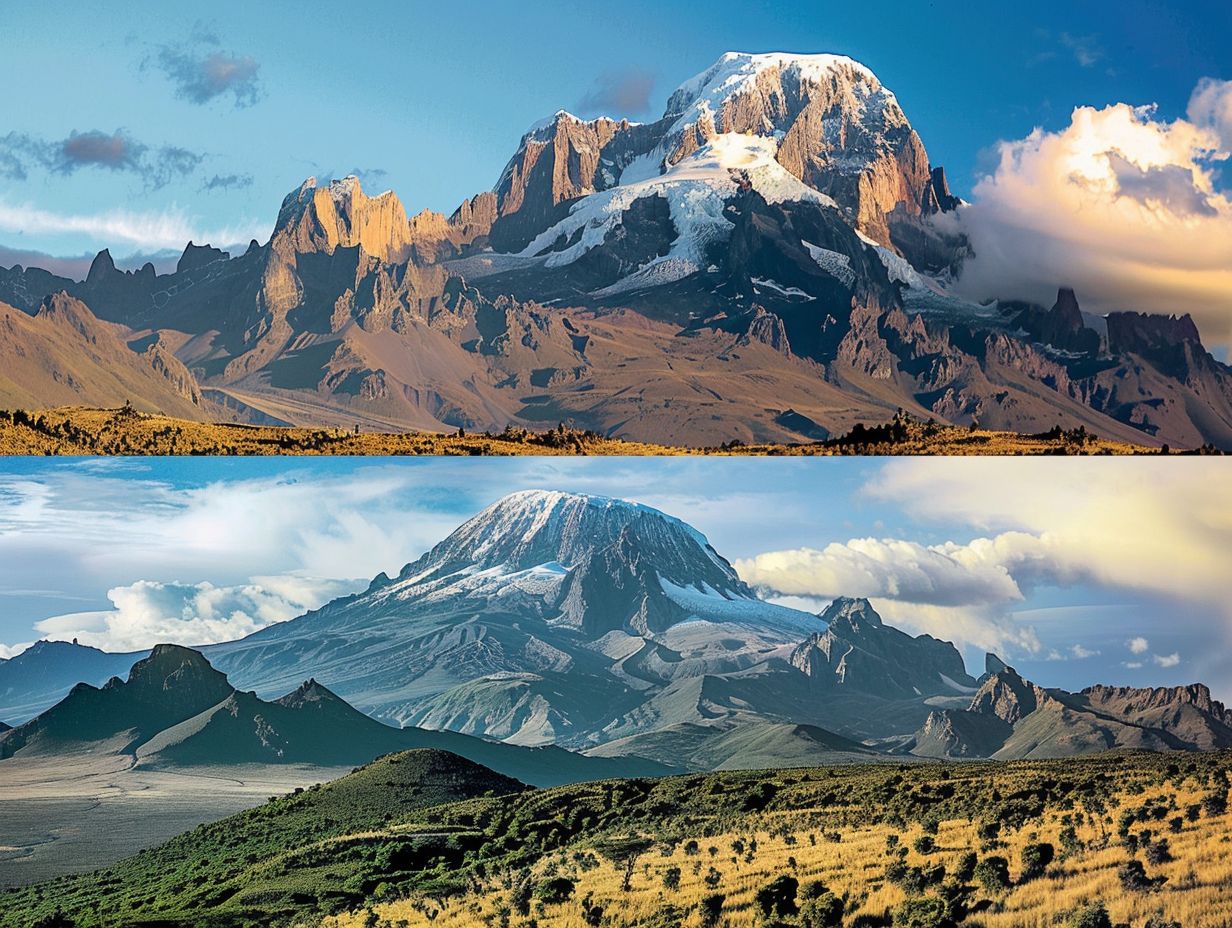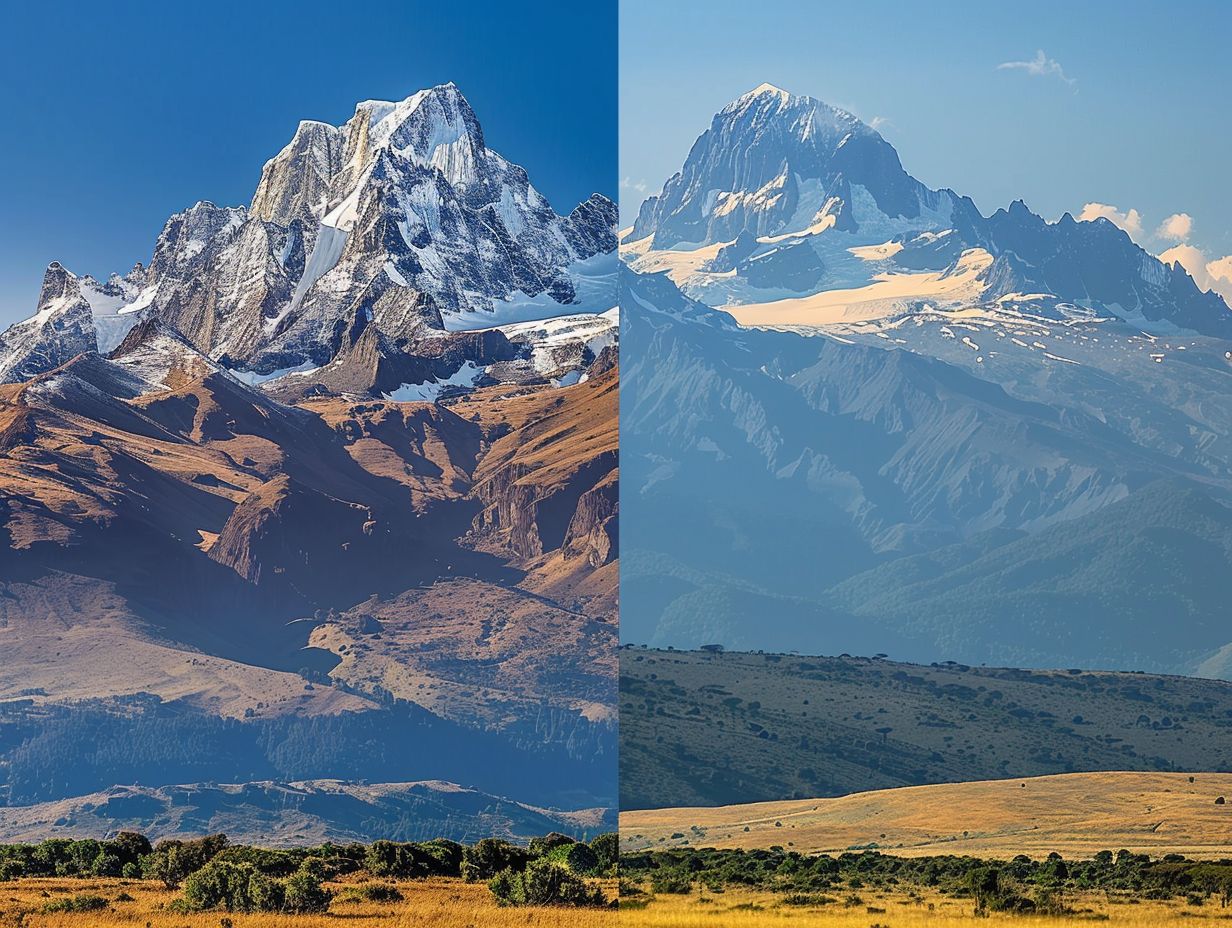
Are you an avid hiker looking to conquer a new challenge?
Mount Kenya and Mount Kilimanjaro are two of Africa’s most iconic peaks, each offering a unique and unforgettable trekking experience.
In this article, we will explore the geographical, flora and fauna, cultural, and trekking differences between these two majestic mountains.
By the end, you’ll have a better understanding of which mountain might be the perfect choice for your next adventure.
So, lace up your boots and get ready to discover the wonders of Mount Kenya and Mount Kilimanjaro!
Key Takeaways:

- Mount Kenya and Mount Kilimanjaro have distinct geographical differences, such as location, elevation, geological composition, and climate.
- The two mountains also have contrasting flora and fauna, with different vegetation zones and animal species inhabiting each.
- Apart from physical differences, Mount Kenya and Mount Kilimanjaro also have cultural differences, including the indigenous people, religious and cultural significance.
Geographical Differences between Mount Kenya and Mount Kilimanjaro
Mount Kenya and Mount Kilimanjaro are two prominent peaks in Africa, each offering a unique climbing experience. Mount Kenya, located in central Kenya, is the second-highest peak in Africa, featuring diverse ecosystems and stunning scenery.
Situated at an impressive altitude of 5,199 meters, Mount Kenya’s snow-capped peaks contrast beautifully with its lush green valleys, making it a favorite among climbers and nature enthusiasts.
In comparison to Mount Kilimanjaro, Mount Kenya’s higher elevation and jagged terrain provide a more challenging climbing experience, attracting experienced adventurers seeking a thrilling ascent. Mount Kenya’s unique equatorial position results in varied vegetation zones, ranging from alpine meadows to dense forests, showcasing its rich biodiversity.
Location and Elevation
Mount Kenya is situated in central Kenya, near Nairobi, while Mount Kilimanjaro is located near the Tanzanian-Kenyan border. Mount Kenya has multiple peaks, with Batian being the highest, while Kilimanjaro boasts the majestic Uhuru Peak as its highest point.
Mount Kenya’s highest peak, Batian, reaches an impressive elevation of 5,199 meters (17,057 feet) above sea level. This mountain is part of a national park with diverse vegetation zones, including rainforest and moorland. The lower slopes of Mount Kenya are home to various wildlife species such as elephants, buffalo, and monkeys.
In contrast, Mount Kilimanjaro is the highest mountain in Africa, soaring to 5,895 meters (19,341 feet) at its summit. Uhuru Peak offers breathtaking views of the surrounding plains and distant mountains in all directions. The snow-capped peak of Kilimanjaro stands in stark contrast to the lush greenery at its base, making it a unique and iconic sight in East Africa.
Geological Composition
The geological composition of Mount Kenya includes volcanic rocks, while Mount Kilimanjaro is a dormant stratovolcano. Mount Kenya features rugged terrain and sharp peaks, contrasting with Kilimanjaro‘s smoother slopes and prominent crater.
These differing geological formations play a crucial role in shaping the experiences of climbers on both mountains. Due to the volcanic rocks on Mount Kenya, climbers often encounter challenging terrains with sharp edges and unstable surfaces, making ascents more demanding and technically challenging.
In comparison, the dormant stratovolcanic structure of Kilimanjaro has resulted in gentler slopes, providing a more accessible route for climbers. The presence of a prominent crater on Kilimanjaro adds a unique feature to its landscape, offering climbers scenic views and a distinct summit experience.
Climate and Weather
The climate on Mount Kenya varies with altitude, ranging from equatorial to alpine, supporting diverse flora and fauna. In contrast, Mount Kilimanjaro experiences distinct climate zones due to its height, with permanent glaciers near the summit.
Mount Kenya, at a lower altitude, has a more diverse range of flora and fauna compared to the barren, snow-covered peaks of Mount Kilimanjaro. The weather on Mount Kenya is influenced by the dry season and the wet season, with the former being the best time for climbing due to clearer skies and stable conditions.
On the other hand, Mount Kilimanjaro witnesses weather variations with heavy precipitation, especially during the wet season, making climbing more challenging and demanding proper gear and preparation.
Flora and Fauna Differences between Mount Kenya and Mount Kilimanjaro

Mount Kenya and Mount Kilimanjaro boast distinct ecosystems, supporting a rich variety of flora and fauna. The vegetation zones on these peaks vary significantly, offering climbers unique encounters with diverse wildlife.
Mount Kenya, standing majestically in the heart of East Africa, is characterized by lush montane forests at lower elevations, which give way to vast alpine moorlands as you ascend.
In contrast, Mount Kilimanjaro features five primary vegetation zones, from cultivated lands and montane forests to heath and alpine deserts near the summit. The diverse ecosystems found on these mountains provide habitats for iconic species such as elephants, leopards, and numerous bird species.
Vegetation Zones
Mount Kenya features distinct vegetation zones, including montane forests, bamboo thickets, and alpine meadows. On the other hand, Mount Kilimanjaro presents zones such as rainforest, heath, moorland, and alpine desert.
Each of these vegetation zones represents a unique ecosystem shaped by the altitude and climate conditions. Starting with Mount Kenya, the montane forests thrive at lower altitudes, characterized by lush greenery, mosses, ferns, and towering trees like camphor and olive. Climbing higher, the bamboo thickets dominate the landscape, creating a dense and vibrant layer of vegetation.
Contrastingly, on Mount Kilimanjaro, the rainforest zone is rich in diversity with giant heather trees, a variety of ferns, and mosses carpeting the ground. Transitioning to the heath zone, one encounters shrubs, grasslands, and unique plant species adapted to the moister conditions. Moving further up into the moorland, the landscape transforms into a picturesque expanse of tussock grasses and wildflowers.
Animal Species
The animal species inhabiting Mount Kenya include elephants, buffalos, and various bird species, adding to the allure of the climb. In contrast, Mount Kilimanjaro is home to unique wildlife like colobus monkeys, leopards, and a variety of birds.
These two incredible African mountains not only offer breathtaking views and challenging climbs but also serve as vital habitats for a diverse range of animal species. Mount Kenya’s lush vegetation provides a perfect environment for elephants and buffalos to thrive, while bird enthusiasts can revel in the sight of various colorful avian species fluttering around.
On Mount Kilimanjaro, the scene changes dramatically to a unique wildlife spectacle – colobus monkeys swinging gracefully through the trees, majestic leopards stealthily roaming the forests, and an orchestra of bird chirps filling the air, making every step up the mountain a memorable encounter with nature.
Cultural Differences between Mount Kenya and Mount Kilimanjaro
Apart from their natural beauty, Mount Kenya and Mount Kilimanjaro hold cultural significance for the indigenous people living in their vicinity. The mountains are steeped in tradition and history, reflecting the deep-rooted connections between the local communities and the land.
For the indigenous people, Mount Kenya is often considered the realm of Ngai, the Supreme Creator, where the Kikuyu people believe their deity resides. The mountain is a sacred site where rituals and ceremonies are performed to honor the spiritual connection between the people and the land.
- Similarly, Mount Kilimanjaro holds a special place in the hearts of the Chagga people, who consider the mountain to be the home of their god, Ruwa, and a place of mystical power and protection.
- Both mountains are central to the cultural heritage of the local communities, with ceremonies, songs, and stories passed down through generations, reinforcing the deep reverence for these natural landmarks.
Indigenous People
The indigenous tribes near Mount Kenya, such as the Kikuyu, Embu, and Meru, have deep cultural ties to the mountain, considering it a sacred site. On the other hand, the Chagga people living around Mount Kilimanjaro have a rich cultural heritage intertwined with the mountain’s history.
For the Kikuyu, Mount Kenya is not just a physical landmark but a spiritual entity believed to be the realm of Ngai, the supreme God in their traditional religion.
They perform rituals and ceremonies to honor and seek blessings from the mountain, often led by elders who hold significant spiritual roles within the community. Similarly, the Embu and Meru tribes share similar beliefs, viewing the mountain as a place of divine presence and ancestral connection.
On the contrary, the Chagga people see Mount Kilimanjaro as a symbol of unity and prosperity among their clans. The mountain is central to their agricultural practices, with rituals performed to ensure fertile soil and abundant harvests. Various ceremonies conducted at different times of the year reflect the Chagga’s reverence for the mountain and its role in sustaining their way of life.
Religious and Cultural Significance

Mount Kenya holds religious significance for various communities, with rituals and ceremonies performed to honor the mountain’s spiritual essence.
Similarly, Mount Kilimanjaro is revered by local tribes, featuring in myths and legends that highlight its cultural importance. The religious beliefs surrounding these mountains often intertwine with the natural features of the landscape, creating a profound connection between the spiritual and physical worlds.
For Mount Kenya, the Kikuyu people believe it is the realm of Ngai, their supreme creator and provider. Various cultural practices like offerings and prayers are carried out to seek blessings and protection from the mountain spirits.
On the other hand, Mount Kilimanjaro is associated with the Maasai people, who consider it as the abode of their god, Enkai. The richness of sacred sites on these mountains showcases the deep-rooted traditions and beliefs that have been passed down through generations.”
Trekking Differences between Mount Kenya and Mount Kilimanjaro
Embarking on a trek up Mount Kenya or Mount Kilimanjaro offers adventurers unique challenges and rewards. While both mountains provide incredible trekking experiences, they differ in terms of climbing routes, success rates, and overall trek durations.
Mount Kenya, standing proudly as Africa’s second-highest peak, offers various climbing routes such as the popular Sirimon and Chogoria routes, each with its own unique landscapes and challenges.
Simultaneously, Mount Kilimanjaro’s treks mainly vary around six official routes, with Machame and Marangu being the most favored among climbers due to their gradual alpine scenery and relatively higher success rates.
On average, climbing Mount Kenya takes around 5-7 days, while ascending Mount Kilimanjaro typically spans 6-8 days, allowing for adequate acclimatization.
Difficulty and Duration
The difficulty levels of trekking on Mount Kenya and Mount Kilimanjaro vary, with factors like altitude, terrain, and weather conditions affecting the challenge. Climbers need to maintain a good fitness level and focus on proper acclimatization to tackle these peaks successfully.
Mount Kenya’s diverse terrain, including rocky paths, dense forests, and glaciers, presents a physical challenge that demands endurance and strength. In contrast, Mount Kilimanjaro’s higher altitude brings a different set of difficulties, such as altitude sickness and extreme cold. To prepare physically, climbers should engage in cardio exercises, strength training, and hiking to build stamina.
Mentally, climbers must be prepared for the long and strenuous journey ahead. Visualizing success, staying positive, and having a strong willpower are key for overcoming the mental hurdles that come with climbing these majestic peaks.
Route Options
Both Mount Kenya and Mount Kilimanjaro offer multiple route options for climbers, catering to varying skill levels and preferences. While some routes feature huts for accommodation, others involve technical climbing challenges that test climbers’ abilities.
On Mount Kenya, the famous routes like Chogoria and Sirimon are known for their diverse landscapes and well-equipped huts along the way, providing climbers with comfortable resting spots. The technical climbing routes such as Nelion and Batian present a thrilling challenge for experienced climbers, requiring strong rock climbing skills.
Meanwhile, Mount Kilimanjaro boasts routes like Marangu and Machame, offering different types of accommodations ranging from huts to camping sites, allowing climbers to choose based on their preferences and comfort levels.
Cost and Permits
When planning a trek up Mount Kenya or Mount Kilimanjaro, climbers need to consider the costs associated with permits, guides, equipment, and other expenses. Securing the necessary permits and understanding the overall climbing costs are essential for a successful and budget-conscious adventure.
Permits for climbing Mount Kenya vary depending on the route chosen, typically ranging between $52 to $124 per person. On Mount Kilimanjaro, permit costs range from $60 to $1000 per person, with additional fees for camping and rescue services.
Hiring experienced guides is crucial, with rates averaging $20 to $30 per day. Essential climbing gear such as proper footwear, clothing, and camping equipment can cost between $500 to $1000.
Conclusion: Which Mountain to Choose for Your Next Adventure?

Deciding between Mount Kenya and Mount Kilimanjaro for your next adventure involves considering factors like fitness level, climbing experience, and personal preferences. Both mountains offer rewarding challenges and breathtaking views, but climbers must prioritize their health, mental strength, and safety when choosing the ideal peak.
When embarking on a trek up Mount Kenya, it’s crucial to be aware of altitude sickness, which can occur above 8,000 feet. To combat this, gradual acclimatization is key, as well as staying properly hydrated and consuming enough calories to fuel your body.
As for Mount Kilimanjaro, the highest freestanding mountain in the world, trekkers should be prepared for the drastic change in altitude as they ascend to the summit. Proper gear, including sturdy footwear and warm clothing, is essential for navigating the varied terrain.
Mental preparedness plays a significant role in summiting either mountain. Positive mindset and determination will help push through physical challenges and unpredictable weather conditions, ensuring a successful and memorable climb.
Frequently Asked Questions
What is the difference between Mount Kenya and Mount Kilimanjaro?
Mount Kenya and Mount Kilimanjaro are two popular mountain peaks in Africa, but they have distinct characteristics that set them apart.
What are the heights of Mount Kenya and Mount Kilimanjaro?
Mount Kenya stands at 5,199 meters (17,057 feet), making it the second-highest mountain in Africa. On the other hand, Mount Kilimanjaro is Africa’s highest mountain, standing at 5,895 meters (19,341 feet).
What are the main differences in the trekking routes for Mount Kenya and Mount Kilimanjaro?
The trekking routes for Mount Kenya and Mount Kilimanjaro differ in length and difficulty level. Mount Kenya has several routes, with the most popular being the Naro Moru and Sirimon routes. Mount Kilimanjaro, on the other hand, has several routes as well, with Marangu and Machame being the most popular ones.
What is the terrain like on Mount Kenya and Mount Kilimanjaro?
Mount Kenya has a diverse terrain with rocky peaks, alpine meadows, and glaciers, making it a challenging climb. Mount Kilimanjaro, on the other hand, has a gentler terrain with gradual inclines and a more gradual ascent.
Are there any differences in the wildlife on Mount Kenya and Mount Kilimanjaro?
Yes, there are noticeable differences in the wildlife on Mount Kenya and Mount Kilimanjaro. Mount Kenya is home to several animal species, including elephants, buffalo, and antelopes, while Mount Kilimanjaro is known for its unique wildlife, such as the Kilimanjaro shrew and the Kilimanjaro tree hyrax.
Can you see both Mount Kenya and Mount Kilimanjaro from either summit?
Although Mount Kenya and Mount Kilimanjaro are located in close proximity, it is not possible to see one from the other’s summit due to their distance and the curvature of the Earth. However, on a clear day, you can see Mount Kenya from certain points on Mount Kilimanjaro and vice versa.